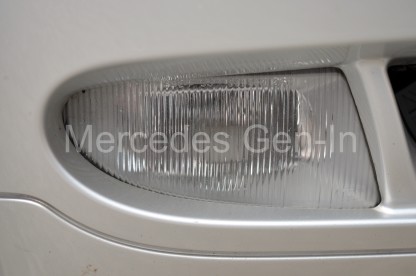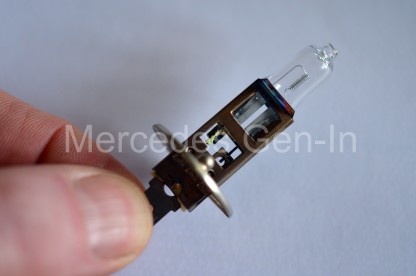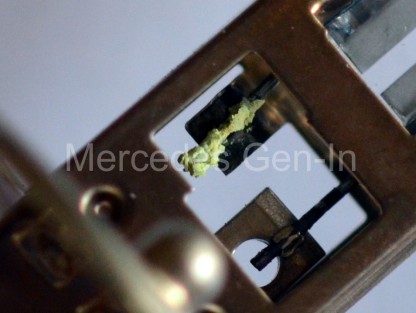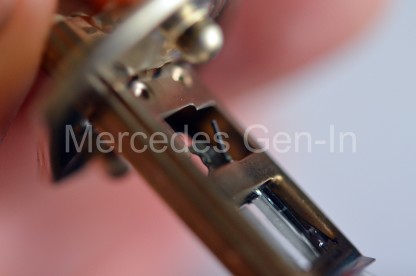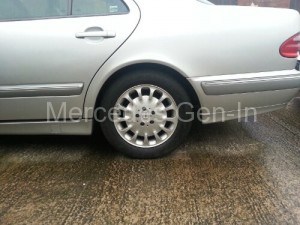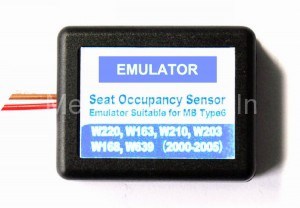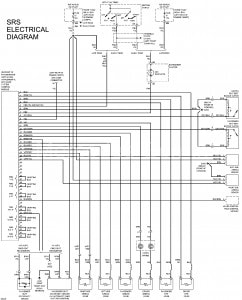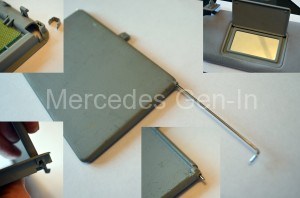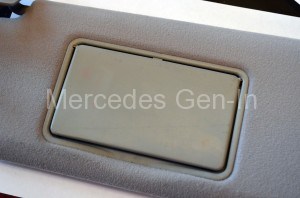Here is a way to deal with a common SRS fault that lies within the seat pad of the Mercedes E Class (W210). (I am sure also similar for other models)
The service history of my current E Class W210 shows repeat visits over 10 years for this specific SRS problem and I would like to share with you the ins and outs of it all (each visit cost the previous owner £220 for the cure/pleasure – only to have it return again almost every 18 months to 2 years during ownership)
If the red SRS lamp on the dash is accompanied by the orange airbag lamp next to the transmission shifter is lit, the fault is commonly connected to the passenger seat sensor. As I imagined the previous owner had always a rather ‘cuddly’ passenger riding shotgun, the seat would have taken a pounding, the flopping into the car was probably the most damaging to the seat related parts I am about to describe.
HOW IT WORKS
Layered within the seat base skin of the passenger seat, there is a complex contact matrix (like a foil printed circuit – looks like an aerial view of a maze) that senses if the seat is occupied (a bum on it) and in most cases with post face-lift models, also auto-senses the proximity of the MB child seat. The former sensor circuit is used to switch off the passenger air bag if the seat is unoccupied, the latter is to used to switch off the passenger air bag when a MB child seat is fitted on the seat. Understanding that the weight may fool the occupancy sensor to thinking an adult bum is on the seat, the child seat detector overrides this and signals the Air Bag Control Module to turn off passenger side airbags. When it does this, the orange Air-Bag off transmission LED illuminates showing the system is disabled and its safe for baby to travel.
On cars pre face lift, without auto child seat detection, the connection from the seat occupancy sensor is connected directly to the Air Bag Control Module and operates just as a simple switch, changing the potential of the signal line to the module when sat on. Post face lift set up is far more complex. There is an electronic box inside the seat base that forms part of the sensor matrix, the ends of the wire ‘maze’ are connected to this and it converts the status of the occupancy detector into a CAN output signal that is piped to the Air Bag Control Module (as a PWM signal) An over simplistic way to imagine this, is to think of it as a pulse, like a heart beat at a fixed rate. This beat is detected by the ABCM (Air bag control module) when the seat is unoccupied and turns off the air bags on passenger side. Once the seat is sat on, the electronic box in the seat changes the frequency of the pulse which is again detected by the ABCM to turn the passenger bags on. The other function of the electronic box within the seat is to auto-detect the presence of the MB child seat, this is done by using RFID (radio frequency identification) working in the same way as the detection alarms at the doors of music shops etc. The RFID token hidden in the child seat is detected by the seat matrix (antenna) and the electronic box then gives out the all important seat unoccupied/child seat in place PWM CAN signal to the ABCM turning off the passenger bags and illuminating the advisory air bag off light.
HOW TO FIX IT
There is a yellow connector beneath the seat, this houses all the connections to the seat pad sensor and links its signals to the ABCM. It is very common for the wires to and around this connector to break (seat-side) as they are very fine conductors indeed and this is compounded by a slight design flaw, in that the cable that enters the seat base to the matrix is tie-wrapped to a metal seat component which in turn causes a stress fracture along the wire length where fixed. So the first thing to check is the connector and it wires (best to remove the seat) If the break is suspected within the depths of the seat base, then it has to be stripped to repair/replace the parts. (This is where the repeat £220 bill from the agents came from!)
Understanding that this is a life saving safety system and the owner may wish to entrust the correct remedial work to a dealer or do it himself with the correct MB parts, there exists however ways to get around this common failure, it is up to you as a reader/owner to make up your own mind if you wish to follow and act on this information. I would not recommend that any of the following solutions be used if the vehicle is or could be used carrying young infants in the front seat, but worth considering if you are grey and old (past it) like me. I have attached a useful wiring diagram of the SRS components so you can identify what’s what on the connector etc. But if you can’t fathom the circuit, then my polite advice to you would be to not mess any further!
So you are still with me…
If your car is a pre face lift, with a non auto detect child seat, then the seat pad matrix can be simply linked out on the yellow connector under the seat. This will signal to the system that someone is sitting in the seat all the time and cause the passenger airbag to be permanently ‘live’ whether anyone is sitting in the seat or not! (In my view better than not working at all) This is a great fault finding tip if nothing else, as it proves if the fault lies within the seat pad, as the SRS lamp and air-bag orange lamp on the transmission will extinguish immediately the ignition is turned on (without a star reset!)
A later auto child seat detecting, post face lift, later E Class W210 model, cannot be ‘linked out’ in any way sorry! It needs a CAN keep alive signal to the ABCM to signify that the system is fault free (default seat unoccupied signal) so any fault occurring in the wiring or seat matrix resulting in the PWM output failing will deny the function of the passenger airbag by default and raise the SRS dash lamp along with the orange air bag transmission mounted indicator. So strip out the seat and remove the leather etc etc…… OR buy a magic box from China from the large online auction sites. This seat sensor emulator box, usually around £15 delivered to your door, provides a seat occupied PWM signal output that once connected, fools the ABCM into thinking all is well and that there is a bum on the passenger seat. There are 3 wires to connect, colour for colour those that exist under the seat Brown, White and Red on the yellow connector. This resets the SRS lights as before on ignition power, without a star reset.
Just for information the China emulator box contains a programmable PIC chip that emulates exactly the signal that would be given from the MB seat pad matrix. Make sure you get the correct one for your correct model if ordering, as there are a couple of types of ABCM used through model years.
So hopefully this has been useful in explaining how the SRS seat sensor system works and that from this you can get an idea what is ahead of you. I tried to find out information like this and its a little sketchy and hard to place so maybe its of some use in your fault finding, diagnostics and resulting repair. The diagram below is especially useful !
SRS Electrical Diagram:
